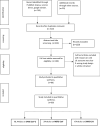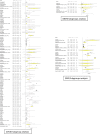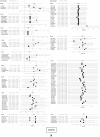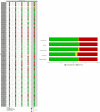Detection of three pandemic causing coronaviruses from non-respiratory samples: systematic review and meta-analysis
- PMID: 34373501
- PMCID: PMC8352881
- DOI: 10.1038/s41598-021-95329-4
Detection of three pandemic causing coronaviruses from non-respiratory samples: systematic review and meta-analysis
Abstract
SARS-CoV-2 has posed an unprecedented challenge to the world. Pandemics have been caused previously by viruses of this family like Middle East Respiratory Corona Virus (MERS CoV), Severe Acute Respiratory Syndrome Corona Virus (SARS CoV). Although these viruses are primarily respiratory viruses, but they have been isolated from non-respiratory samples as well. Presently, the detection rate of SARS-CoV-2 RNA from different clinical specimens using Real Time Reverse Transcriptase Polymerized Chain Reaction (qRT-PCR) after onset of symptoms is not yet well established. Therefore, the aim of this systematic review was to establish the profile of detecting SARS-CoV-2, MERS CoV, SARS CoV from different types of clinical specimens other than the respiratory using a standard diagnostic test (qRT-PCR). A total of 3429 non-respiratory specimens were recorded: SARS CoV (total sample-802), MERS CoV (total sample-155), SARS CoV-2 (total sample-2347). Out of all the samples studied high positive rate was seen for saliva with 96.7% (14/14; 95% CI 87.6-100.0%) for SARS CoV and 57.5% (58/250; 95% CI - 1.2 to 116.2%) for SARS CoV-2, while low detection rate in urine samples for SARS CoV-2 with 2.2% (8/318; 95% CI 0.6-3.7%) and 9.6% (12/61; 95% CI - 0.9 to 20.1%) for SARS CoV but there was relatively higher positivity in urine samples for MERS CoV with detection rate of 32.4% (2/38; 95% CI - 37.3 to 102.1%). In Stool sample positivity was 54.9% (396/779; 95% CI 41.0-68.8%), 45.2% (180/430; 95% CI 28.1-62.3%) and 34.7% (4/38; 95% CI - 29.5 to 98.9%) for SARS CoV-2, MERS CoV, and SARS CoV, respectively. In blood sample the positivity was 33.3% (7/21; 95% CI 13.2-53.5%), 23.7% (42/277; 95% CI 10.5-36.9%) and 2.5% (2/81; 95% CI 0.00-5.8%) for MERS CoV, SARS CoV-2 and SARS CoV respectively. SARS-CoV-2 along with previous two pandemic causing viruses from this family, were highly detected stool and saliva. A low positive rate was recorded in blood samples. Viruses were also detected in fluids along with unusual samples like semen and vaginal secretions thus highlighting unique pathogenic potential of SARS-CoV-2.
© 2021. The Author(s).
Conflict of interest statement
The authors declare no competing interests.
Figures






References
Publication types
MeSH terms
Substances
LinkOut - more resources
Full Text Sources
Miscellaneous

